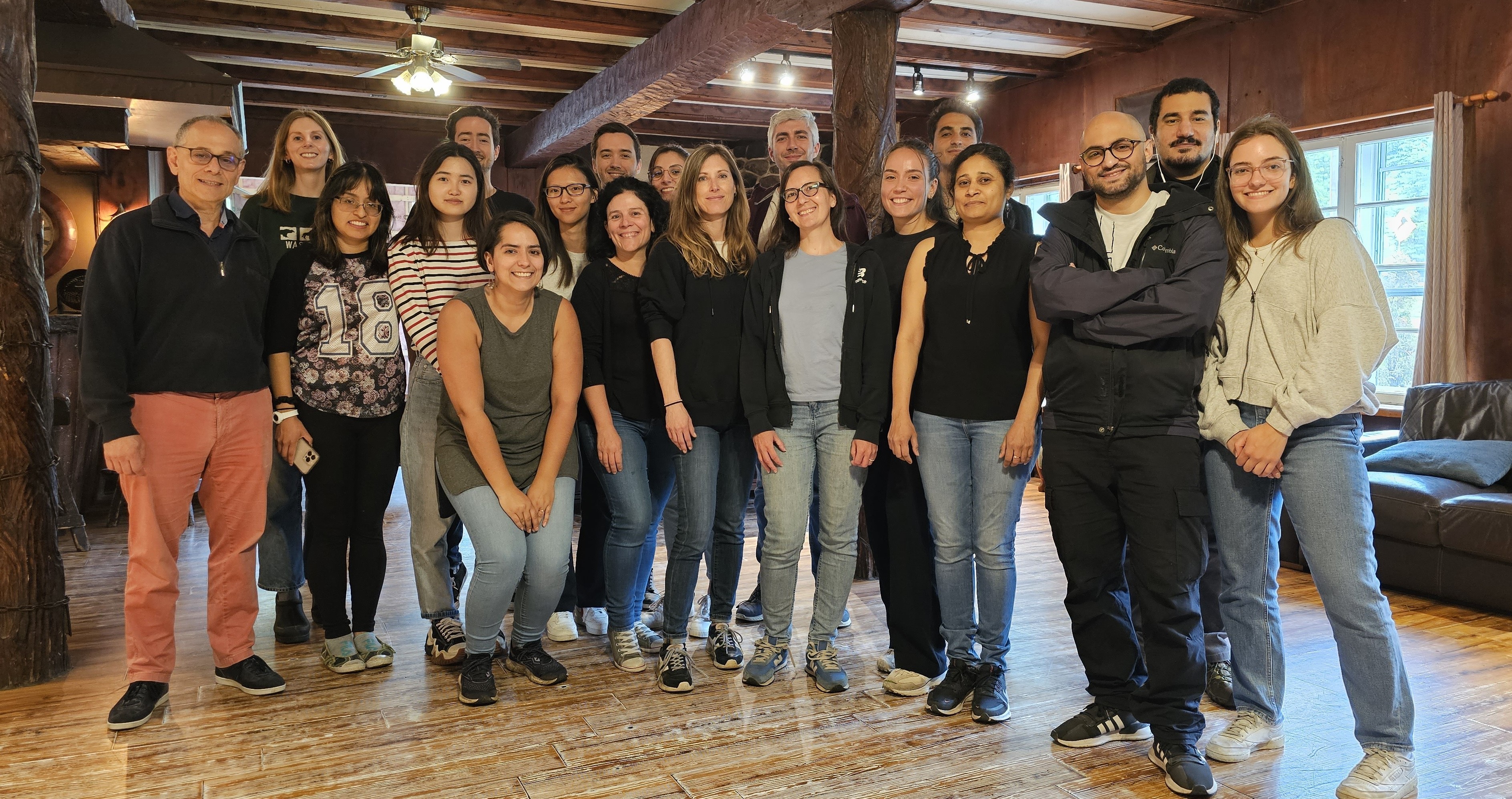
PRINCIPAL INVESTIGATOR

Edward Fon, MD, FRCP (C)
ted.fon [at] mcgill.ca (ted[dot]fon[at]mcgill[dot]ca)
Dr. Edward Fon, MD, FRCP(C) is a neurologist-scientist at the Montreal Neurological Institute-Hospital (The Neuro) specializing in movement disorders and a Professor in the Department of Neurology and Neurosurgery at McGill University. He is the Director of the FRQS Quebec Parkinson Network and the Scientific Director of The Neuro. He was trained at the Université de Montréal, McGill University and the University of California, San Francisco (UCSF). His research focuses on the molecular and cellular events leading to Parkinson's disease (PD). His laboratory has made contributions to understanding the function and cell biology of PD genes and in understanding how defects in these genes lead to PD. In particular, his lab has focused on understanding the function of Parkin, PINK1, α-synuclein, GBA, LRRK2, TMEM175 and DJ1, and has established the infrastructure at The Neuro to study these genes and pathways in human patient-derived induced pluripotent stem cells (iPSCs), which are differentiated into neurons, glia and 3D brain organoids. The lab is currently using these iPSC systems to establish a pipeline to better understand the role of lesser-studied PD genes, identified in recent genome-wide association studies (GWAS), in PD pathogenesis. In addition, Dr. Fon helped establish the Tanenbaum Open Science Institute (TOSI) at The Neuro and oversees its platforms including the Clinical Biological Imaging and Genetic repository (C-BIGr) and iPSC/CRISPR Early Drug Discovery Unit (EDDU).
List of publications - NCBI bibliography
POSTDOCTORAL FELLOWS

Divya Shiroor, PhD
Despite decades of research uncovering genetic and environmental risk factors for the fatal neurodegenerative disorders Parkinson’s disease (PD) and Multiple System Atrophy (MSA), the mechanisms driving their progression remain poorly understood. My research investigates how genetic predisposition, in combination with everyday environmental toxins, shapes disease advancement. By integrating human stem cell models with environmental toxicology and chemical biology, I aim to generate new insights into the pathways that underlie PD and MSA progression.
List of publications
Shiroor, D.A.*, Wang, K*., Adler, C.E. (2023). Inhibition of ATM kinase rescues planarian regeneration after lethal radiation. EMBO Reports E5112.
Wendt G., Shiroor, D.A.,Adler CE, Collins JJ III. (2022). Convergent evolution of "genome guardian" functions in a parasite-specific p53 homolog. PNAS e2205201119.
Bohr T.E., Shiroor, D.A., and Adler C.E. (2021) Planarian Stem Cells Sense the Identity of Missing Tissues to Launch Targeted Regeneration. eLife 10:e68830.
Shiroor, D.A., Bohr, T.E., Adler, C.E. (2020) Injury Delays Stem Cell Apoptosis after Radiation in Planarians. Current Biology 30, 2166–2174.
Shiroor, D.A., Bohr, T.E., Adler, C.E. (2018) Chemical Amputation and Regeneration of the Pharynx in the Planarian Schmidtea mediterranea. J.Vis.Exp. 133: e57168.
Kour, S., Garimella, M.G.,Shiroor, D.A., et al. (2016) IL-3 Decreases Cartilage Degradation by Downregulating Matrix Metalloproteinases and Reduces Joint Destruction in Osteoarthritic Mice. J Immunol. 196(12):5024-5035.
Camille Lacarriere-Keita, PhD
camille.lacarriere [at] mcgill.ca
List of publications
PhD STUDENTS

Emma MacDougall
emma.macdougall [at] mail.mcgill.ca (emma[dot]macdougall[at]mail[dot]mcgill[dot]ca)
I study the role of LRRK2 and Rab GTPases in the pathogenesis of Parkinson's disease by using induced pluripotent stem cell (iPSC) based models. I focus particularly on understanding the role of LRRK2-Rab signaling in iPSC derived microglia, and co-culturing microglia and neurons in 3 dimensions. My goal is to unravel the mechanisms underlying LRRK2-Rab communication and neuroinflammation in Parkinson's disease.
List of publications
Yi, W., MacDougall, E. J., Tang, M. Y., Krahn, A. I., Gan-Or, Z., Trempe, J. Fon, E. A. (2019) The landscape of Parkin variants reveals pathogenic mechanisms and therapeutic targets in Parkinson’s disease. Hum. Mol. Genet. 28, 2811–2825
Fava, V. M., Xu, Y. Z., Lettre, G., Van Thuc, N., Orlova, M., Thai, V. H., Tao, S., Croteau, N., Eldeeb, M. A., MacDougall, E. J., Cambri, G., Lahiri, R., Adams, L., Fon, E. A., Trempe, J., Cobat, A., Alcaïs, A., Abel, L., Schurr, E. (2019) Pleiotropic effects for Parkin and LRRK2 in leprosy type-1 reactions and Parkinson’s disease. Proc. Natl. Acad. Sci. U.S.A. 116, 15616–15624
Eldeeb, M. A., MacDougall, E. J., Ragheb, M. A., Fon, E. A. (2019) Beyond ER: Regulating TOM-Complex-Mediated Import by Ubx2. Trends Cell Biol. 29, 687–689

Ghislaine Deyab
ghislaine.deyab [at] mail.mcgill.ca (ghislaine[dot]deyab[at]mail[dot]mcgill[dot]ca)
My research focuses on characterizing neural activity present in human derived midbrain organoids as a model of Parkinson’s disease (PD). Organoids are a promising tool that can be used to study neurodegenerative diseases on a patient specific level. There is evidence showing that organoids exhibit certain aspects of disease pathology such as the inclusion of protein aggregates and neuronal death, complementary to what we see occur in human models of PD. However, there is extensive literature showing that PD also causes abnormal activity in basal ganglia circuits, namely increased bursting activity and synchronization between basal ganglia nuclei. My aim is to determine whether midbrain organoids can accurately model the changes in neural activity associated with PD. To do this, I will conduct an in-depth analysis of electrophysiological properties, pathological markers, and pharmacological testing on PD patient-derived hMOs and their isogenic controls. My goal is to validate the reliability of using organoids as a model to study neurodegenerative diseases in a patient specific manner.
List of publications
Khoo S.Y.-S., Lecocq M.,Deyab, G., Chaudhri, N. (2019) Context and topography determine the role of basolateral amygdala metabotropic glutamate receptor 5 in appetitive Pavlovian responding. Neuropsychopharmacology 44(9):1524-1533

Zaid Al-Azzawi
zaid.al-azzawi [at] mail.mcgill.ca (zaid[dot]al-azzawi[at]mail[dot]mcgill[dot]ca)
My project is focused on the biochemical profiling of α-synuclein aggregates from various cellular models of Parkinson’s disease (PD). α-synuclein aggregation is a pathological hallmark of a group of diseases known as synucleinopathies. Recent research has shown α-synuclein forms different fibrils capable of adopting self-perpetuating conformations, known as strains, which may characterize distinct clinical synucleinopathy syndromes. This could explain why and how α-synuclein aggregates can be present in various Parkinsonian diseases and yet lead to different patterns of disease progression and cellular damage. Leveraging the advantages of patient-derived 3D midbrain organoids, my goal is to develop a bioassay for the detection and characterization of pathological α-synuclein aggregates and to screen for patient-specific therapeutics.
List of publications
Arshad H, Patel Z, Mehrabian M, Bourkas MEC, Al-Azzawi ZAM, Schmitt-Ulms G, Watts JC. (2021) The aminoglycoside G418 hinders de novo prion infection in cultured cells. J Biol Chem. 297(3):101073
So RWL, Chung SW, Lau HHC, Watts JJ, Gaudette E, Al-Azzawi ZAM, Bishay J, Lin LT, Joung J, Wang X, Schmitt-Ulms G. (2019) Application of CRISPR genetic screens to investigate neurological diseases. Mol Neurodegener. 14(1):41.
Bourkas MEC, Arshad H, Al-Azzawi ZAM, Halgas O, Shikiya RA, Mehrabian M, Schmitt-Ulms G, Bartz JC, Watts JC. (2019) Engineering a murine cell line for the stable propagation of hamster prions. J Biol Chem. 294(13):4911-4923.

Nathan Karpilovsky
nathan.karpilovsky [at] mail.mcgill.ca (nathan[dot]karpilovsky[at]mail[dot]mcgill[dot]ca)
My research at the Fon lab focuses on the effect of novel genes on α-synuclein aggregate propagation in Parkinson’s Disease. The spread of α-synuclein throughout the central nervous system is believed to be one of the main contributors to the progressive nature of the disease. Particularly, I am interested in the mechanisms involved in the uptake and accumulation of α-synuclein aggregates in neurons. In my research, I utilize CRISPR activation and interference to study the effect of specific gene modulation on the accumulation of lab-generated α-synuclein preformed fibrils in cells. My goal is to elucidate the mechanisms of α-synuclein uptake and accumulation in iPSC-derived neurons, and uncover possible therapeutic targets for the treatment of Parkinson’s disease.
List of publications

Isabella Pietrantonio
isabella.pietrantonio [at] mail.mcgill.ca (isabella[dot]pietrantonio[at]mail[dot]mcgill[dot]ca)
The accumulation of protein aggregates composed mainly of alpha-synuclein is a major hallmark of Parkinson’s disease. The mechanisms through which these aggregates exert their toxicity have not yet been fully elucidated, yet their ability to disrupt degradation systems within the cell has been suggested. The lysosome is at the heart of these degradation pathways, therefore highlighting its importance. My project aims to explore the role of lysosomal function in Parkinson's Disease (PD) pathology by investigating genetic modulators of lysosomal rupture induced by pre-formed fibrils of recombinant alpha-synuclein (PFFs).
List of publications

Donovan Worral
donovan.worrall [at] mail.mcgill.ca (donovan[dot]worrall[at]mail[dot]mcgill[dot]ca)
I work on the characterization of antibodies that target GWAS-associated Parkinson's disease genes. I will then use these antibodies to investigate these understudied genes with the hope of discovering their role in PD pathology.
List of publications
Worrall D, Ayoubi R, Fotouhi M, Southern K, McPherson PS, Laflamme C, NeuroSGC/YCharOS/EDDU collaborative group, ABIF Consortium. (2023) The identification of high-performing antibodies for TDP-43 for use in Western Blot, immunoprecipitation and immunofluorescence. F1000Research 12, 277
Ayoubi R, Ryan J, Biddle MS, Alshafie W, Fotouhi M, Bolivar SG, Ruiz Moleon V, Eckmann P, Worrall D, McDowell I, Southern K, Reintsch W, Durcan TM, Brown C, Bandrowski A, Virk H, Edwards AM, McPherson P, Laflamme C (2023) Scaling of an antibody validation procedure enables quantification of antibody performance in major research applications. eLife 12, RP91645
Ayoubi R, Worrall D, et al. (2023) Antibody Characterization Report for Angiogenin. Zenodo
Fotouhi M, Ryan J, Reintsch W, Worrall D, et al. (2023) Antibody Characterization Report for Alsin. Zenodo
Fotouhi M, Ryan J, Worrall D, et al. (2023) Antibody Characterization Report for RNA-binding protein TIA1. Zenodo
Worrall D, et al. (2022) Antibody Characterization Report for Rho Gdp-dissociation Inhibitor 1 (rho GDI 1). Zenodo
RESEARCH ASSOCIATES

Thomas Goiran, PhD
thomas.goiran [at] mail.mcgill.ca (thomas[dot]goiran[at]mail[dot]mcgill[dot]ca)
My research focuses on the effect induced by toxic accumulation of protein aggregates essentially composed of the protein Alpha-Synuclein. These aggregates are tought to be involved in neuronal decay in the brains of patients with Parkinson's disease, leading to loss of cognition and death. We do not know the genetic actors contributing to this neuronal toxicity. In order to identify and validate new target genes for the development of new therapeutic treatments, I combine the increased growth and division ability of cultured cell lines and the physiological relevance of a dopaminergic neuron model generated from induced pluripotent stem cells from healthy individuals and Parkinson's patients. The goal of my project is to reduce or prevent this toxicity and excessive neuronal death characteristic of Parkinson's disease.
List of publications
Roberts R., Bayne AN., Goiran T., Lévesque D., Boisvert FM., Trempe JF., Fon EA., (2021). Proteomic Profiling of Mitochondrial-Derived Vesicles in Brain Reveals Enrichment of Respiratory Complex Sub-assemblies and Small TIM Chaperones. J Proteome Res ; 20(1):506-517.
Checler F, Goiran T, Alves da Costa C. (2018). Nuclear TP53: An unraveled function as transcriptional repressor of PINK1. Autophagy ; 14(6):1099-1101.
McLelland GL, Goiran T, Yi W, Dorval G, Chen CX, Lauinger ND, Krahn AI, Valimehr S, Rakovic A, Rouiller I, Durcan TM, Trempe JF, Fon EA. (2018). Mfn2 ubiquitination by PINK1/parkin gates the p97-dependent release of ER from mitochondria to drive mitophagy. Elife ; pii: e32866
Goiran T, Duplan E, Rouland L, El Manaa W, Lauritzen I, Dunys J, You H, Checler F, Alves da Costa C. (2018). Nuclear p53-mediated repression of autophagy involves PINK1 transcriptional down-regulation. Cell Death and Differentiation ; 25(5):873-884
Goiran T, Duplan E, Chami M, Bourgeois A, El Manaa W, Rouland L, Dunys J, Lauritzen I, You H, Stambolic V, Biféri MG, Barkats M, Pimplikar SW, Sergeant N, Colin M, Morais VA, Pardossi-Piquard R, Checler F, Alves da Costa C. (2018). β-Amyloid Precursor Protein Intracellular Domain Controls Mitochondrial Function by Modulating Phosphatase and Tensin Homolog-Induced Kinase 1 Transcription in Cells and in Alzheimer Mice Models. Biological Psychiatry ; 1;83(5):416-427
Checler F, Goiran T, Alves da Costa C. (2017). Presenilins at the crossroad of a functional interplay between PARK2/PARKIN and PINK1 to control mitophagy: Implication for neurodegenerative diseases. Autophagy ; 13(11):2004-2005
CLoubière C, Goiran T, Laurent K, Djabari Z, Tanti JF, Bost F. (2015). Metformin-induced energy deficiency leads to the inhibition of lipogenesis in prostate cancer cells. Oncotarget ; 20;6(17):15652-61
Viotti J, Duplan E, Caillava C, Condat J, Goiran T, Giordano C, Marie Y, Idbaih A, Delattre JY, Honnorat J, Checler F, Alves da Costa C. (2014). Glioma tumor grade correlates with parkin depletion in mutant p53- linked tumors and results from loss of function of p53 transcriptional activity. Oncogene ; 3;33(14):1764-75
Duplan E, Sevalle J, Viotti J, Goiran T, Bauer C, Renbaum P, Levy-Lahad E, Gautier CA, Corti O, Leroudier N, Checler F, da Costa CA. (2013). Parkin differently regulates presenilin-1 and presenilin-2 functions by direct control of their promoter transcription. Journal of Molecular Cell Biology ; Apr;5(2):132-42

Rhalena Thomas, PhD
rhalena.thomas [at] mcgill.ca (rhalena[dot]thomas[at]mcgill[dot]ca)
I develop analysis tools for induced pluripotent stem cells derived neurons and 3D tissue models ("mini-brains"). My goal is to integrate transcriptional data from single cell sequencing and cellular imaging data to understand the pathological processes involved in Parkinson's disease.
List of publications
Del Cid-Pellitero E, Tavassoly O, Larroquette F, Cai E, Thomas RA, Soubannier V, Luo W, Durcan TM, Fon EA. (2021) Pharmacological Inhibition of Brain EGFR Activation By a BBB-penetrating Inhibitor, AZD3759, Attenuates α-synuclein Pathology in a Mouse Model of α-Synuclein Propagation. Neurotherapeutics.
Vogel JW, La Joie R, Grothe MJ, Diaz-Papkovich A, Doyle A, Vachon-Presseau E, Lepage C, de Wael RV, Thomas RA, Iturria-Medina Y, Bernhardt B. (2020) A molecular gradient along the longitudinal axis of the human hippocampus informs large-scale behavioral systems. Nature communications 11(1):1-7
Thomas RA, Gibon J, De Leon, A, Chen, CXQ, Chierzi, S, Baulac, S, Murai, KK, Barker PA. (2018) The Nogo Receptor Ligand LGI1 Regulates Synapse Number and Synaptic Activity in Hippocampal and Cortical Neurons. eNeuro 0185-18
Thomas RA, Metzen MG and Chacron MJ. (2018) Weakly electric fish distinguish between envelope stimuli arising from different behavioral contexts. Journal of experimental biology 221: jeb178244
Gibon J, Unsain N, Gamache K, Thomas RA, De Leon A, Johnstone A, Nader K, Sequela P, Barker PA. (2016) The X-linked inhibitor of apoptosis regulates long-term depression and learning rate. FASEB J. 30(9):3083
Thomas RA, Ambalavana A, Rouleau GA, Barker PA. (2016) Identification of genetic variants of LGI1 and RTN4R (NgR1) linked to schizophrenia that are defective in NgR1–LGI1 signaling. Molecular Genetics and Genomic Medicine. 4(4): 447–456
Kommaddi R, Thomas R, Ceni C, Daigneault K, Barker PA. (2011) Trk-dependent ADAM17 activation facilitates neurotrophin survival signalling. FASEB J. 10-173740
Ceni C, Kommaddi R, Thomas R, Vereker E, McPherson PM, Ritter B, Liu X, Barker PA. (2010) The p75NTR intracellular domain is generated by neurotrophin-induced receptor cleavage to potentiate Trk signalling. Journal of Cell Science 123(13):2299-307
Thomas R, Favell K, Morante-Redolat JM, Pool, M, Kent C, Wright M, Daignault K, Ferraro G, Montcalm S, Durocher Y, Fournier A, Perez-Tur J, Barker PA. (2010) LGI1 is a Novel Nogo Receptor 1 ligand that antagonizes myelin-based growth inhibition. Journal of Neuroscience 30(19):6607-12

Roxanne Larivière, PhD
roxanne.lariviere [at] mcgill.ca (roxanne[dot]lariviere[at]mcgill[dot]ca)
My research interest lies in better understanding the role of GWAS-associated PD genes and characterize the lesser-studied PD genes in genetically-modified induced pluripotent stem cell derived midbrain organoids. With the use of PD phenotypic assays and unbiased multi-omics, we hope to disentangle the PD GWAS-ome by uncovering new pathways or mechanisms in PD pathology and new key targets for therapy
List of publications
Choquet K, Pinard M, Yang S, Moir RD, Poitras C, Dicaire M-J, Sgarioto N, Larivière R, Kleinman CL, Willis IM, Gauthier M-S, Coulombe B, Brais B. (2019) The leukodystrophy mutation Polr3b R103H causes homozygote mouse embryonic lethality and impairs RNA Polymerase III biogenesis. Mol. Brain
Larivière R, Sgarioto N, Toscano Márquez B, Gaudet R, Choquet K, McKinney RA, Watt AJ, Brais B. (2019) Sacs R272C missense homozygous mice develop an ataxia phenotype. Mol. Brain
Walker CL, Uchida A, Li Y, Trivedi N, Fenn JD, Monsma PC, Larivière RC, Julien JP, Jung P, Brown A. (2019) Local Acceleration of Neurofilament Transport at Nodes of Ranvier. J Neurosci.
Gentil BJ, Lai GT, Menade M, Larivière R, Minotti S, Gehring K, Chapple JP, Brais B, Durham HD. (2018) Sacsin, mutated in the ataxia ARSACS, regulates intermediate filament assembly and dynamics. FASEB J.
Ady V, Toscano-Márquez B, Nath M, Chang PK, Hui J, Cook A, Charron F, Larivière R, Brais B, McKinney RA, Watt AJ. (2018) Altered synaptic and firing properties of cerebellar Purkinje cells in a mouse model of ARSACS. J Physiol.
Duncan EJ, Larivière R , Bradshaw TY, Longo F, Sgarioto N, Hayes MJ, Romano LEL, Nethisinghe S, Giunti P, Bruntraeger MB, Durham HD, Brais B, Maltecca F, Gentil BJ, Chapple JP. (2017) Altered organization of the intermediate filament cytoskele-ton and relocalization of proteostasis modulators in cells lacking the ataxia protein sacsin. Hum Mol Genet.
Choquet K, Yang S, Moir RD, Forget D, Larivière R , Bouchard A, Poitras C, Sgarioto N, Dicaire MJ, Noohi F, Kennedy TE, Roch-ford J, Bernard G, Teichmann M, Coulombe B, Willis IM, Klein-man CL, Brais B. (2017) Absence of neurological abnormalities in mice homozygous for the Polr3a G672E hypomyelinating leukodystrophy mutation. Mol Brain.
Larroquette F, Seto L, Gaub PL, Kamal B, Wallis D, Larivière R, Vallée J, Robitaille R, Tsuda H. (2015) Vapb/Amyotrophic lateral sclerosis 8 knock-in mice display slowly progressive motor behavior defects accompanying ER stress and autophagic response. Hum Mol Genet.
Larivière R, Gaudet R, Gentil BJ, Girard M, Conte TC, Minotti S, Leclerc-Desaulniers K, Gehring K, McKinney RA, Shoubridge EA, McPherson PS, Durham HD, Brais B. (2015) Sacs knockout mice present pathophysiological defects underlying autosomal recessive spastic ataxia of Charlevoix-Saguenay. Hum Mol Genet.
Thiffault I, Dicaire MJ, Tetreault M, Huang KN, Demers-La-marche J, Bernard G, Duquette A, Larivière R, Gehring K, Montpetit A, McPherson PS, Richter A, Montermini L, Mercier J, Mitchell GA, Dupré N, Prévost C, Bouchard JP, Mathieu J, Brais B. (2013) Diversity of ARSACS mutations in French-Canadians. Can J Neurol Sci.
Girard M1, Larivière R1, Parfitt DA, Deane EC, Gaudet R, Noss-ova N, Blondeau F, Prenosil G, Vermeulen EGM, Duchen MR, Richter A, Shoubridge EA, Gehring K, McKinney RA, Brais B, Chapple JP, and McPherson PS. (2012 10) Mitochondrial dysfunction and Purkinje cell loss in autosomal recessive spastic ataxia of Charlevoix-Saguenay (ARSACS) PNAS (1: co-authors)
Ezzi SA, Larivière R, Urushitani M, Julien JP. (2010) Neuronal over-ex-pression of chromogranin A accelerates disease onset in a mouse model of ALS. J. Neurochem.
Dequen F, Filali M, Larivière RC, Perrot R, Hisanaga S, Julien JP. (2010) Reversal of neuropathy phenotypes in conditional mouse model of Charcot-Marie-Tooth disease type 2E. Hum Mol Genet.
Gros-Louis F, Soucy G, Larivière R, Julien JP. (2010) Intracerebroven-tricular infusion of monoclonal antibody or its derived Fab fragment against misfolded forms of SOD1 mutant delays mortality in a mouse model of ALS. J Neurochem.
Eriksson KS, Zhang S, Lin L, Larivière RC, Julien JP, Mignot E. (2008) The type III neurofilament peripherin is expressed in the tubero-mammillary neurons of the mouse. BMC Neurosci.
Millecamps S, Robertson J, Lariviere R, Mallet J, Julien JP. (2006) Defective axonal transport of neurofilament proteins in neurons overexpressing peripherin. J Neurochem.
Gros-Louis F, Larivière R, Gowing G, Laurent S, Camu W, Bouchard JP, Meininger V, Rouleau GA, Julien JP. (2004) A frameshift deletion in peripherin gene associated with amyotrophic lateral sclerosis. J Biol Chem.
Nguyen MD, Shu T, Sanada K, Larivière RC, Tseng HC, Park SK, Julien JP, Tsai LH. (2004) A NUDEL¬dependent mechanism of neurofil-ament assembly regulates the integrity of CNS neurons. Nat Cell Biol.
Lariviere RC, Julien JP. (2004) Functions of intermediate filaments in neuronal development and disease. J Neurobiol. Review.
Larivière RC, Beaulieu JM, Nguyen MD, Julien JP. (2003) Peripherin is not a contributing factor to motor neuron disease in a mouse model of amyotrophic lateral sclerosis caused by mutant superoxide dismutase. Neurobiol Dis.
Larivière RC, Nguyen MD, Ribeiro-da-Silva A, Julien JP. (2002) Reduced number of unmyelinated sensory axons in peripher-in null mice. J Neurochem.
Nguyen MD, Larivière RC, Julien JP. (2001) Deregulation of Cdk5 in a mouse model of ALS: toxicity alleviated by perikaryal neurofil-ament inclusions. Neuron.
Nguyen MD, Larivière RC, Julien JP. (2000) Reduction of axonal caliber does not alleviate motor neuron disease caused by mutant superoxide dismutase 1. Proc Natl Acad Sci U S A.
MANAGEMENT

Frédérique Larroquette, MSc
frederique.larroquette [at] mcgill.ca (frederique[dot]larroquette[at]mcgill[dot]ca)
I am managing the lab in its day to day organization.
List of publications
Tavassoly O, Del Cid-Pellitero E, Larroquette F, Cai E, Thomas RA, Soubannier V, Luo W, Durcan TM, Fon EA. (2021) Pharmacological Inhibition of Brain EGFR Activation By a BBB-penetrating Inhibitor, AZD3759, Attenuates α-synuclein Pathology in a Mouse Model of α-Synuclein Propagation. Neurotherapeutics.
Mohamed NV., Larroquette F., Beitel LK, Fon EA, Durcan TM. (2019) One step into the future: new iPSC tools to advance research in Parkinson’s disease and neurological disorders. Journal of Parkinson’s disease doi: 10.3233/JPD-181515
Larroquette F, Seto L, Gaub PL, Kamal B, Wallis D, Larivière R, Vallée J, Robitaille R, Tsuda H. (2015) Vapb/Amyotrophic lateral sclerosis 8 knock-in mice display slowly progressive motor behavior defects accompanying ER stress and autophagic response. Human Molecular Genetics ; 24(22):6515-29.
UNDERGRADUATE STUDENTS
Siddarth Gollapudi
siddharth.gollapudi [at] mail.mcgill.ca (siddharth[dot]gollapudi[at]mail[dot]mcgill[dot]ca)
Olivia Partridge
olivia.partridge [at] mail.mcgill.ca (olivia[dot]partridge[at]mail[dot]mcgill[dot]ca)
Nadja finkel
nadja.finkel [at] mail.mcgill.ca (nadja[dot]finkel[at]mail[dot]mcgill[dot]ca)
Lauren Dorsey
lauren.dorsey [at] mail.mcgill.ca (lauren[dot]dorsey[at]mail[dot]mcgill[dot]ca)

